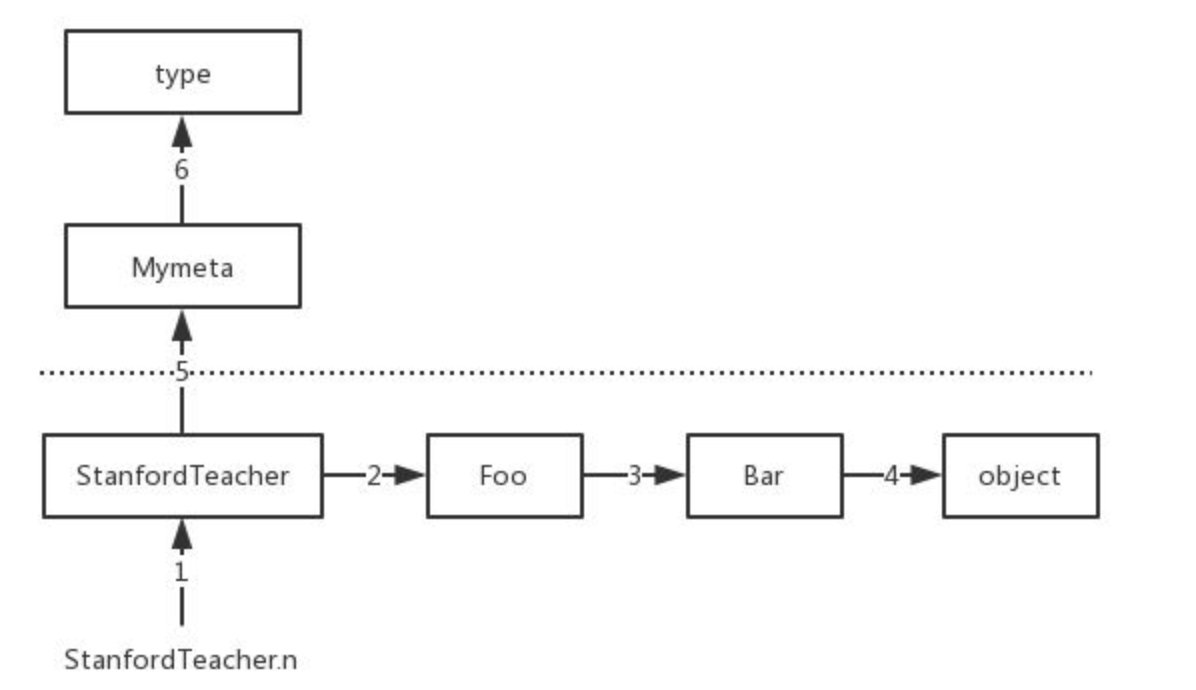python 的元类
2021-02-16 06:16
标签:__str__ img super teacher str stanford 控制 func __new__ 在 python 中,一切皆为对象,类其实也是对象,为什么这么说??类时通过调用元类产生的 元类就是用来实例化产生类的类,它的作用就是用来产生自定的类 关系:元类---->实例化------>类------>实例化------>对象(obj) 查看内置的元类: 1、type 是内置的元类 2、我们用 class 关键字定义的所有类以及内置的类都是由元类 type 实例化产生的 类有三大特征: 补充:exec 的用法 调用 Mymeta 发生三件事,调用Myneta就是==> type.__ call __ (): 自定义元类可以控制类的产生过程,类的产生过程其实就是元类的调用过程 People = Mymeta() ---> type.__ call __ ==>干了3件事 强调: 只要是调用类,那么会依次调用: 案例: 在该类内部添加 __ call __方法,可以实现对象( )的调用 对象() --->类的__ call __ 案例:我们可以通过改写__ call __的逻辑从而控制调用StanfordTeacher的过程,比如将StanfordTeacher的对象的所有属性都变成私有的 控制类的调用即是控制类的对象的产生 People = Mymeta() ---> type.__ call __ ==>干了3件事 obj = People(‘egon‘, 18) ==> Mymeta.__ call __ ===>干了3件事 我们用class自定义的类也全都是对象(包括object类本身也是元类type的 一个实例,可以用type(object)查看)。 属性查找的原则:对象----》类------》父类 注:父类不是元类 属性查找应该分成两层,一层是对象层(基于c3算法的MRO)的查找,另外一个层则是类层(即元类层)的查找 1)类的属性查找,可以找到元类 2)对象的属性查找,找不到元类 案例二: 通过自定义元类产生的类的属性查找 分析元类 Mymeta 中__ call __ 里的 self. __ new __的查找 总结: Mymeta下的__ call __ 里的self.__ new __ 在StanfordTeacher、Foo、Bar里都没有找到 __ new __ 的情况下,会去找object里的 __ new __ ,而object下默认就有一个 __ new __ ,所以即便是之前的类均未实现 __ new __ ,也一定会在object中找到一个,根本不会、也根本没必要再去找元类Mymeta->type中查找 __ new__ 在元类的__ call __ 中是可以用object.__ new__ (self)去造对象,但是还是推荐在 __ call __ 中使用self. __ new __ (self)去创造空对象,因为这种方式会检索三个类StanfordTeacher->Foo->Bar,而object. __ new __则是直接跨过了他们三个 python 的元类 标签:__str__ img super teacher str stanford 控制 func __new__ 原文地址:https://www.cnblogs.com/xy-han/p/12709556.html一 引入
二 什么是元类
class People:
def __init__(self, name, age):
self.name = name
self.age = age
def say(self):
print(‘%s:%s‘%(self.name, self.age))
# print(People.__dict__)
#如何得到对象
# obj = 调用类()
obj = People(‘egon‘, 18)
print(type(obj)) #print(type(People)) #三 class 关键字创造类的步骤
1、类名
class_name = "People"
2、类的基类
class_bases = (object,)
3、执行类体代码拿到类的名称空间
class_dic = {} #定义一个局部名称空间
class_body = """
def __init__(self, name, age):
self.name = name
self.age = age
def say(self):
print(‘%s:%s‘%(self.name, self.age))
"""
exec(class_body, {}, class_dic)
print(class_dic) #{‘__init__‘: #exec:三个参数
#参数一:包含一系列python代码的字符串
#参数二:全局作用域(字典形式),如果不指定,默认为globals()
#参数三:局部作用域(字典形式),如果不指定,默认为locals()
#可以把exec命令的执行当成是一个函数的执行,会将执行期间产生的名字存放于局部名称空间中
g={
‘x‘:1,
‘y‘:2
}
l={}
exec(‘‘‘
global x,z
x=100
z=200
m=300
‘‘‘,g,l)
print(g) #{‘x‘: 100, ‘y‘: 2,‘z‘:200,......} 全局名称空间
print(l) #{‘m‘: 300} 局部名称空间
4、调用元类
People = type(class_name, class_bases, class_dic)
print(People) #四 如何自定义元类来控制类的产生
1、自定义元类
class Mymeta(type): #只有继承了 type 类的类才是元类
# def __init__(cls,*args, **kwargs):
# print(args) #args = (class_name, class_bases, class_dic)
def __init__(self, class_name, class_bases, class_dic):
super().__init__(class_name, class_bases, class_dic)
print(self) #
1、先造一个空对象==》People,调用Mymeta 类内的__ new __ 方法
2、调用 Mymeta这个类内的__ init __方法,完成初始化对象的操作
3、返回初始好的对象2、定义类的过程详解
1、type.__ call __ 函数内会先调用 Mymeta内的 __ new__
2、type.__ call __ 函数内会再调用Mymetan内的 __ init__
3、type.__ call__函数内会返回一个初始化好的对象# class People(metaclass=Mymeta): #===》People = Mymeta(‘类名‘, (object,), 类的名称空间)
class People(metaclass=Mymeta): #===》People = Mymeta(‘People‘, (), {...})
def __init__(self, name, age):
self.name = name
self.age = age
def say(self):
print(‘%s:%s‘ % (self.name, self.age))
# 结果展示
‘‘‘
__new__ run....
1、类内的__ new __
2、类内的__ init __class Mymeta(type): #只有继承了type类才能称之为一个元类,否则就是一个普通的自定义类
def __init__(self,class_name,class_bases,class_dic):
# print(self) #五 __ call __
类() ----->自定义元类内的__ call __
自定义元类() ---->内置元类(type)的__ call __class Foo:
def __init__(self,x,y):
self.x = x
self.y = y
def __call__(self, *args, **kwargs):
print(‘====>‘,args, kwargs)
return "__call__ 触发了"
obj = Foo(111, 222)
# print(obj.__str__()) # <__main__.foo object at> 默认返回的是对象的内存地址
print(obj) # 等同于 obj.__str___
#应用: 对象加空号调用,需要在该对象的类中添加一个方法__call__
res = obj(1,2,3, a=4, b=5, c=6) #等同于 obj.__call__()
print(res) #__call__ 触发了
# 结果展示:
‘‘‘
====> (1, 2, 3) {‘a‘: 4, ‘b‘: 5, ‘c‘: 6}
‘‘‘
# 总结:
‘‘‘
对象() --->类的__call__
类() ----->自定义元类内的__call__
自定义元类() ---->内置元类(type)的__call__
‘‘‘
class Mymeta(type): #只有继承了type类才能称之为一个元类,否则就是一个普通的自定义类
def __call__(self, *args, **kwargs): #self=六 自定义元类控制类的调用
1、自定义元类
class Mymeta(type): #只有及继承了type 类的类才是元类
def __call__(self, *args, **kwargs):
print(‘--->‘, self.__name__) # ---> People
#1、Mymeta.__call__函数内部会先调用 People 内的__new__
people_obj= self.__new__(self, *args, **kwargs) #得到一个空对象,此处的self是People类
# 查看初始化前的的对象的属性
print(‘people对象初始化前的属性:‘, people_obj.__dict__) # {}
#2、Mymeta.__call__函数会调用 People 内的__init__ 初始化对象
self.__init__(people_obj, *args, **kwargs) #初始化空对象
#查看初始化后对象的属性
print(‘people对象初始化后的属性:‘, people_obj.__dict__) # {‘name‘: ‘egon‘, ‘age‘: 18}
people_obj.__dict__[‘xxxxx‘] = 11111
# 3、Mymeta.__call__函数内会返回一个初始化好的对象
return people_obj
2、类的产生
1、type.__ call __ 函数内会先调用 Mymeta内的 __ new__
2、type.__ call __ 函数内会再调用Mymetan内的 __ init__
3、type.__ call__函数内会返回一个初始化好的对象lass People(metaclass= Mymeta):
def __init__(self, name, age):
self.name = name
self.age = age
def say(self):
print(‘%s:%s‘ % (self.name, self.age))
def __new__(cls, *args, **kwargs):
#产生真正的people_obj对象
return object.__new__(cls) #调用父类的__new__方法产生空对象
3、类的调用
1、Mymeta.__ call __ 函数内会先调用People内的 __ new__
2、Mymeta. __ call__ 函数内会调用People内的 __ init__
3、Mymeta.__ call __函数会返回一个初始化好的对象obj1=People(‘egon‘,18)
obj2=People(‘egon‘,18)
print(obj1.__dict__) #{‘name‘: ‘egon‘, ‘age‘: 18, ‘xxxxx‘: 11111}
print(obj2.__dict__) #{‘name‘: ‘egon‘, ‘age‘: 18, ‘xxxxx‘: 11111}
七 属性查找
class Mymeta(type): #只有及继承了type 类的类才是元类
n=444
def __call__(self, *args, **kwargs): #self=class Mymeta(type): #只有及继承了type 类的类才是元类
n=444
def __call__(self, *args, **kwargs): #self=
class Mymeta(type):
n=444
def __call__(self, *args, **kwargs): #self=